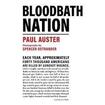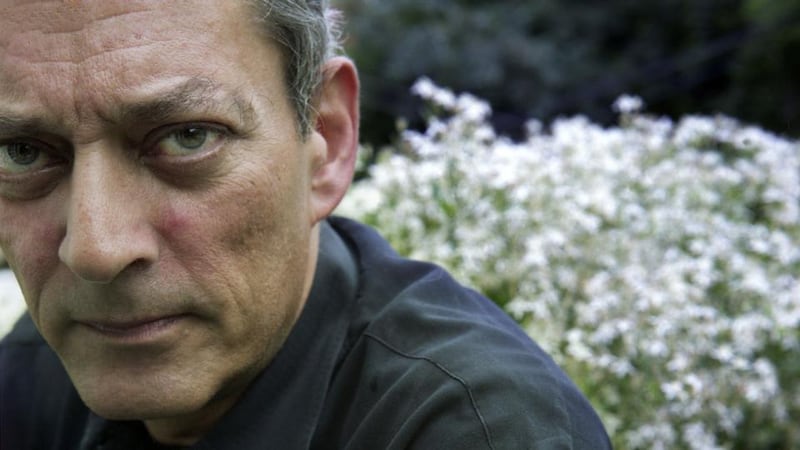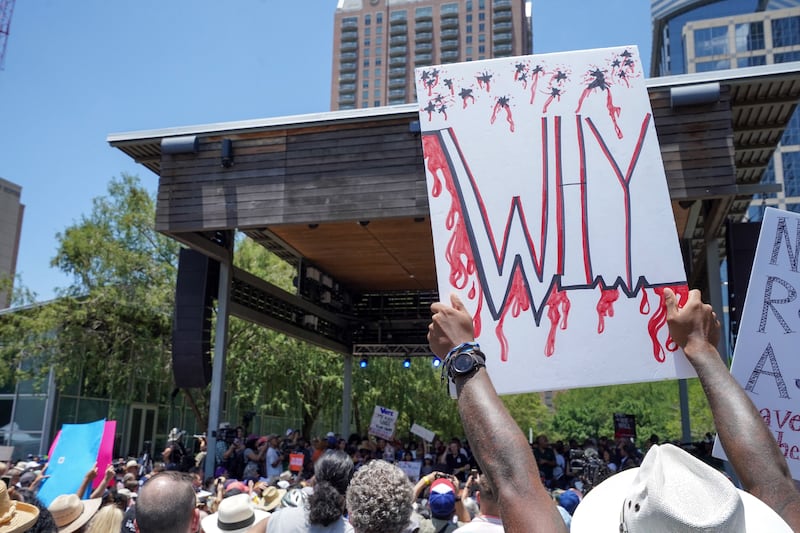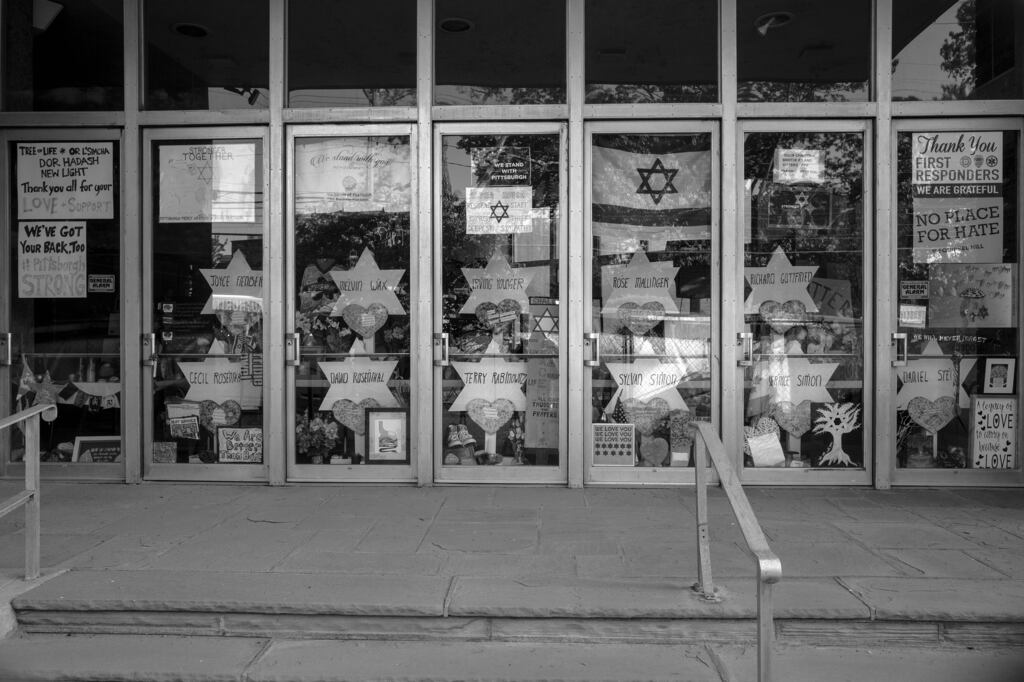
Paul Auster grew up during the golden age of the television western, when traditional cowboy films, originally made for the cinema, shared the small screen with purpose-made series such as Hopalong Cassidy and The Lone Ranger.
“My heroes were good-hearted dumbbells, slow to anger, reluctant to talk, and shy around women, but they knew right from wrong, and they could outpunch and outshoot the crooked ones whenever a ranch or a herd of cattle or the safety of the town were threatened,” he writes in Bloodbath Nation, an extended essay on America’s gun culture.
As a boy, Auster discovered, pretty much by accident, that he himself was handy with guns. One summer his parents sent him to a camp that included among its activities shooting lessons with .22 rifles. He had a gift for hitting paper targets. Later, he spent one afternoon on a friend’s farm “skeet” shooting – firing shotguns at clay discs as they are hurled through the air. He hit every one. So he is a little puzzled himself, writing now in his seventies, that he never bothered with firearms again.
“Had I come from a different background, there is every chance I would have embraced guns as an integral part of my life. Such is the case for tens of millions of Americans across the country, and if I had grown up elsewhere with another set of parents in another sort of community, and if I had been encouraged by my father to take up shooting as one of the fundamental imperatives of manhood, a boy with my innate marksmanship talents surely would have followed his example with enthusiasm. But my father was not one of those men, and therefore I was not one of those boys.”
READ MORE
Bloodbath Nation is mostly a forceful and vivid work of long-form polemic, but it is bound together by a vital thread of memoir, a family secret, and a coincidence to match any of those that the author built into his novels. No spoilers, but there is a reason why his father “was not one of those men” who put guns in the hands of their children.
It helped, too, Auster writes, that he grew up in a time and place (New Jersey) where guns were still not part of the everyday culture, where no one he knew hunted, or talked about guns, or owned one, or thought them necessary for self-defence. It was only in his twenties, during a short stint in the Merchant Marine, that he encountered American gun culture – he identifies it in particular with the southern states – at second hand.
A young mechanic on one of his ships, whom he had thought affable and harmless, confesses to Auster that when he was bored, back home in Baton Rouge, he would take his rifle on to a highway overpass and shoot at random cars. Another shipmate (also from Louisiana), on shore leave with Auster in Tampa, decides to call home. When he rejoins Auster, he informs him in passing that his brother has just been jailed for shooting a man in a bar fight.
“Such things happen every night in bars, pubs and cafes all across the world, but the bloody noses and aching jaws that generally follow from these dust-ups in Canada, Norway, or France often turn out to be gunshot wounds in the United States. The numbers are both stark and instructive. Americans are twenty-five times more likely to be shot than their counterparts in other wealthy, so-called advanced countries, and with less than half the population of those other two dozen countries combined, eighty-two per cent of all gun deaths take place here. The difference is so large, so striking, so disproportionate to what goes on elsewhere, that one must ask why. Why is America so different – and what makes us the most violent country in the western world?”

The Old West was a far more civilised, peaceful, and safer place than American society is today
— Paul Auster
One answer, he determines, is to be found in America’s intimately brutal colonial prehistory. White male settlers were expected to serve for life in their local militias, to keep a musket and ammunition handy for use against the native peoples whose land they were stealing. In the south, armed “slave patrols” had the right to stop, interrogate and brutalise any black person they encountered: they “constituted the first police force in America, and until the end of the Civil War, they functioned as a kind of Southern Gestapo”.
A second explanation is to be found in the ever-growing number and lethal power of the firearms in civilian hands.
“People shoot other people with guns because they have guns, and people commit suicide with guns because they have guns, and the more guns there are to be bought and the more people there are to buy them, the more people will kill themselves and others with guns. This is not a moral or political statement – it is a question of pure mathematics. Hand out boxes of matches to twenty young children at a birthday party, and there is every chance that the house will burn down before the party is over.”
So far, so obvious. Yet plenty of other countries in the “Anglosphere”- Australia, South Africa, Canada, Ireland – have traditions of settler violence. And there are other regions of the world – in particular parts of the Middle East – where guns and their private ownership are fetishised as attributes of manhood. But only in the United States is there, on average, roughly one mass shooting every day. Only there do men – it is always men, Auster notes – take legally-acquired military rifles into primary schools, churches, universities and night clubs, with the intention of killing everyone they can, and killing themselves in the process.
It is, unsurprisingly, these acts of pointless, nihilistic, postmodernist slaughter that trouble Auster the most. His text is interpolated with a series of black and white photographs by photographer Spencer Ostrander, detached and desolate, devoid of human figures, showing the locations of more than 30 mass killings, both famous and obscure.
“They are portraits of buildings, often bleak, ugly buildings in undistinctive, neutral American landscapes, forgotten structures where horrendous massacres were carried out by men with rifles and guns, briefly capturing the country’s attention and then fading into oblivion until Ostrander showed up with his camera and transformed them into gravestones of our collective grief.”
Why, Auster asks, do they do it? What makes them so twisted and toxic that they resolve to give up their lives by making war against the very idea of society itself? He might have said, against the very concepts of love and life.

“The single word that runs through all their stories is loneliness,” he concludes, “unbearable, mind-crushing loneliness, which is the same loneliness that drives millions of other Americans to seek comfort in various forms of obliteration – too many drugs, too much alcohol, and obsessive fugues into the labyrinthine pathways of the Internet.”
Fumbling, as one must, in such darkness, he reaches for Let’s Shoot, a poem by Hilton Obenzinger:
“Let’s go to church and shoot
Let’s go to the movies and shoot
Let’s go to the music festival
Let’s go to the supermarket
Let’s go to the school ...
... So much to shoot and so little time
Let’s shoot the small quiet wind
That blows through our hearts
And kill it good
As for the cowboy films, they were a lie, all gun smoke and mirrors:
“From 1877 to 1886 there were a total of fifteen homicides in Dodge City (1.5 per year); in 1881, Tombstone’s most violent year on record, five people were killed (three of them in the skirmish at the O.K. Corral); and in Deadwood’s most violent year the total was four ... the Old West was a far more civilised, peaceful, and safer place than American society is today.”
The reason for this? Gun control. It was forbidden to carry weapons in these wild frontier towns. From their earliest history, the American colonies, and the states that replaced them, bristled with rules to restrict the ownership and use of firearms. Yet Auster, in pointing this out, has little faith that the modern US will revert to such common-sense arrangements. He cites Antonin Scalia, the “originalist” Republican Supreme Court judge who wrote the landmark 2008 District of Columbia v Heller judgment that threw out many remaining gun controls.
[ The Irish Times view on US gun control: a national scandalOpens in new window ]
In 2012, Auster notes, Scalia told a public gathering in Princeton that “I have classes of little kids who come to the court, and they recite very proudly what they have been taught, ‘The Constitution is a living document.’ It isn’t a living document. It’s dead. Dead, dead, dead!”
Such gleeful scorn, directed at innocent, idealistic schoolchildren, delivered with the cadence of an automatic rifle. Dead, dead, dead.
Further reading
The United States may be the epicentre of mass shootings, but they occur, though much more rarely, in other countries. Dunblane: Our Year of Tears (Mainstream, 1997) by Peter Samson and Alan Crow, records the memories of twelve people touched by the massacre of 16 children and a teacher at a primary school in Dunblane, Scotland in 1996. The shooting prompted new laws that all but banned private ownership of hand guns in the UK.
On the night of November 14th, 1959 two drifters shot dead the four members of the Clutter family in their rural home in Holcomb, Kansas. In Cold Blood (Random House, 1966), Truman Capote’s non-fiction masterpiece, is an early examination of the toxic, rootless “loneliness” and randomised hate that Auster sees as a common thread in American mass shootings.
The Hidden History of Guns and the Second Amendment (Berrett-Koehler, 2019), by liberal radio commentator Thom Hartmann, provides a detailed guide to the legal and social contexts of gun ownership and abuse in the United States.















